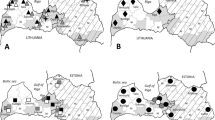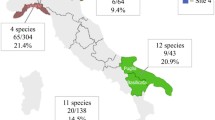Abstract
The medical and veterinary significance of ticks and tick-borne pathogens (TBPs) in tropical and subtropical zones is well recognized. Although ticks and TBPs are known to occur in Southeast Asia, limited data is available in the international literature for some countries, such as Vietnam. The aim of this study was to investigate the species of ticks and TBPs associated with dogs in northern Vietnam. Out of 359 dogs enrolled in this study, 26.2% (n = 94) were infested by 466 ticks (i.e., 287 males, 139 females, 30 nymphs, and 10 larvae). All ticks were morphologically identified as Rhipicephalus sanguineus sensu lato, and some of them genetically characterized as belonging to the tropical lineage. A total of 302 ticks were molecularly screened for the detection of selected TBPs. Three ticks were positive for Hepatozoon canis, one for Ehrlichia canis, and one for Babesia vogeli, representing the first molecular characterization of these pathogens in Vietnam. In conclusion, the tropical lineage of R. sanguineus s.l. is the dominant tick taxon infesting dogs from northern Vietnam, where different TBPs are circulating.
Similar content being viewed by others
References
Alexander AD, Binn LN, Elisberg B, Husted P, Huxsoll DL, Marshall JD, Needy CF, White AD (1972) Zoonotic infections in military scout and tracker dogs in Vietnam. Infect Immun 5:745–749
Burlini L, Teixeira KR, Szabó MP, Famadas KM (2010) Molecular dissimilarities of Rhipicephalus sanguineus (Acari: Ixodidae) in Brazil and its relation with samples throughout the world: is there a geographical pattern? Exp Appl Acarol 50:361–374
Chin S (2018) Thriving dog meat trade. The ASEAN post. https://theaseanpostcom/article/thriving-dog-meat-trade. Last accessed on 11th August 2018
Dantas-Torres F (2008) The brown dog tick Rhipicephalus sanguineus (Latreille 1806) (Acari: Ixodidae): from taxonomy to control. Vet Parasitol 52:173–185
Dantas-Torres F, Latrofa MS, Annoscia G, Giannelli A, Parisi A, Otranto D (2013) Morphological and genetic diversity of Rhipicephalus sanguineus sensu lato from the new and old worlds. Parasit Vectors 6:213
Inokuma H, Okuda M, Ohno K, Shimoda K, Onishi T (2002) Analysis of the 18S rRNA gene sequence of a Hepatozoon detected in two Japanese dogs. Vet Parasitol 106:265–271
Inpankaew T, Hii SF, Chimnoi W, Traub RJ (2016) Canine vector-borne pathogens in semi-domesticated dogs residing in northern Cambodia. Parasit Vectors 9:253
Irwin PJ, Jefferies R (2004) Arthropod-transmitted diseases of companion animals in Southeast Asia. Trends Parasitol 20:27–34
Keirans JE (2009) Order Ixodida. In: Krantz GE, Walter DE (eds) A manual of acarology, 3rd edn. Texas Tech University Press, Texas, pp 111–117
Kelch WJ (1984) The canine ehrlichiosis (tropical canine pancytopenia) epizootic in Vietnam and its implications for the veterinary care of military working dogs. Mil Med 149:327–331
Koh FX, Kho KL, Kisomi MG, Wong LP, Bulgiba A, Tan PE, Lim YAL, Nizam QNH, Panchadcharam C, Tay ST (2018) Ehrlichia and Anaplasma infections: serological evidence and tick surveillance in Peninsular Malaysia. J Med Entomol 55:269–276
Kolonin GV (1995) Review of the Ixodid tick fauna (Acari: Ixodidae) of Vietnam. J Med Entomol 32:276–282
Latrofa MS, Dantas-Torres F, Giannelli A, Otranto D (2014) Molecular detection of tick-borne pathogens in Rhipicephalus sanguineus group ticks. Ticks Tick Borne Dis 5:943–946
Liu M, Ruttayaporn N, Saechan V, Jirapattharasate C, Vudriko P, Moumouni PFA, Cao S, Inpankaew T, Ybañez AP, Suzuki H, Xuan X (2016) Molecular survey of canine vector-borne diseases in stray dogs in Thailand. Parasitol Int 65:357–361
Martin AR, Brown GK, Dunstan RH, Roberts TK (2005) Anaplasma platys: an improved PCR for its detection in dogs. Exp Parasitol 109:176–180
Ngo TC, Nguyen DT, Tran HH, Le TH, Nguyen HT, Diep TT et al (2011) Imported dogs as possible vehicles of Vibrio cholerae O1 causing cholera outbreaks in northern Vietnam. The Open Infectious Diseases Journal 5:127–134
Nuchjangreed C, Somprasong W (2007) Ectoparasite species found on domestic dogs from Pattaya district Chonburi province Thailand. Southeast Asian J Trop Med Publ Health 38:203–207
Olmeda AS, Armstrong PM, Rosenthal BM, Valladares B, del Castillo A, de Armas F, Miguelez M, González A, Rodrı́guez Rodrı́guez JA, Spielman A, Telford III SR (1997) A subtropical case of human babesiosis. Acta Trop 67:229–234
Otranto D, Dantas-Torres F, Breitschwerdt EB (2009) Managing canine vector-borne diseases of zoonotic concern: part one. Trends Parasitol 25:157–163
Parola F, Cornet J, Ose’e Sanogo Y, Miller RS, Huynh VT, Gonzalez J, Raoult D, Telford SR, Wongsrichanalai C (2003) Detection of Ehrlichia spp. Anaplasma spp. Rickettsia spp. and other eubacteria in ticks from the Thai-Myanmar border and Vietnam. J Clin Microbiol 41:1600–1608
Petney TN, Kolonin GV, Robbins RG (2007) Southeast Asian ticks (Acari: Ixodida): a historical perspective. Parasitol Res 2:101
Phan TC, Doan VT, Nguyen VC (1977) Ve bet va con trung ky sinh o Viet Nam Tap 1 Ve (Ixodoidea) Mo ta va phan loai. Khoa hoc va Ky thuat, Hanoi 1:469–478
Prakash BK, Low VL, Tan TK, Vinnie-Siow WY et al (2018a) Detection of Hepatozoon canis in the brown dog tick and domestic dogs in Peninsular Malaysia. J Med Entomol 55:1346–1348
Prakash BK, Low VL, Vinnie-Siow WY et al (2018b) Detection of Babesia spp. in dogs and their ticks from Peninsular Malaysia: emphasis on Babesia gibsoni and Babesia vogeli infections in Rhipicephalus sanguineus sensu lato (Acari: Ixodidae). J Med Entomol 55:1337–1340
Tran NHB, Nguyen HH (2014) Tinh hinh nhiem ngoai ky sinh trung tren cho tai thanh pho Can Tho. Can Tho Junior of Science 2:69–73
Walker JB, Keirans JE, Horak IG (2005) The genus Rhipicephalus (Acari Ixodidae): a guide to the brown ticks of the world. Cambridge University Press, Cambridge
Watanabe M, Nakao R, Amin-Babjee SM, Maizatul AM, Youn JH, Qiu Y, Sugimoto C, Watanabe M (2015) Molecular screening for Rickettsia Anaplasmataceae and Coxiella burnetii in Rhipicephalus sanguineus ticks from Malaysia. Trop Biomed 32:390–398
Wells K, Beaucournu JC, Durden LA, Petney TN, Lakim MB, O’Hara RB (2012) Ectoparasite infestation patterns of domestic dogs in suburban and rural areas in Borneo. Parasitol Res 111:909–919
Ybañez AP, Perez ZO, Gabotero SR, Yandug RT, Kotaro M, Inokuma H (2012) First molecular detection of Ehrlichia canis and Anaplasma platys in ticks from dogs in Cebu Philippines. Ticks Tick Borne Dis 3:288–293
Ybañez AP, Ybañez RH, Talle MG, Liu M, Moumouni PF, Xuan X (2017) First report on Babesia vogeli infection in dogs in the Philippines. Parasitol Int 66:813–815
Author information
Authors and Affiliations
Corresponding author
Ethics declarations
Conflicts of interest
The authors declare that they have no conflict of interest.
Ethical approval
Informed consent and agreement were obtained from dog owners before sampling ticks. All applicable international, national, and/or institutional guidelines for the care and use of animals were followed.
Additional information
Handling editor: Julia Walochnik
Rights and permissions
About this article
Cite this article
Nguyen, V.L., Colella, V., Iatta, R. et al. Ticks and associated pathogens from dogs in northern Vietnam. Parasitol Res 118, 139–142 (2019). https://doi.org/10.1007/s00436-018-6138-6
Received:
Accepted:
Published:
Issue Date:
DOI: https://doi.org/10.1007/s00436-018-6138-6




